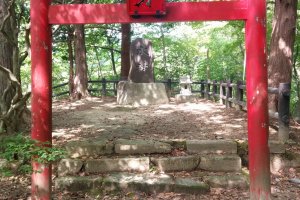Two legendary heroes separated by 250 years both struggled to fight against impossible foes. One wrestled with fire, the other disease. Hanging in the balance would be the future of a million people, the city's current population. The solution to both these problems was to control the giver of life: water. This is the back story to the development of Japan's third oldest water system found in Sendai, Miyagi Prefecture. With such an epic introduction I researched online, I knew I had to head to the Sendai Waterworks Museum to see how the epic unfolded.
Sendai has a compact city center, but stretches geograhically from the Pacific Ocean to the mountains bordering Yamagata Prefecture. The Sendai Waterworks Museum is towards the latter, being accessed via a 40 minute drive from JR Sendai Station or a 20 minute walk from Kumagane Station along the Senzan line. The area is full of nature. In fact the adjacent hiking trails are considered part of the experience. An easy stroll takes you past an old management office with round retro windows, a miniture garden, or a unique goat head fountain (it no longer works). Picnic tables are found nearby to soak up the scene. A longer trail takes you over the Aoba Dam #1 then up winding stairs to a simple statue enshrining the spirit of a water deity. The dam is one of a kind with its white waterfall effect, courtesy of a design that sends water over sloped rocks. It is said an expert with a good eye can read the quaility of the water as it falls to the river below. Dam fanatics come here just to see the historic dam, taking pride in the "dam card" given to them upon entering the museum.
Inside the admission free museum, you'll find attractions for both adults and children. The first floor hosts a timeline and information panels (Japanese only, but basic English pamphlets availiable), a small handful of aging sewer technology artifacts, and imaginative pictures. The second floor gives a broader explanation of how water is recycled through nature, and how the water systems of Earth are all connected. Many toys and cartoonish panels make this fun for the kids. I enjoyed the historic photos the most, particulary one with a man standing in a gigantic storm drain tunnel three times his height.
The water system history represented in the museum tells a very interesting story. 400 years ago Date Masamune, the local feudal lord, was developing the city. With 50,000 people, the castle town was massive for the time period. The samurai city engineer created an extensive canal system called the Yotsuya Yosui. Redirecting part of the Hirose River into a series of above and underground waterways throughout the city, citizens were awarded water for daily use and a nearby relief measure to combat unfogiving fires.
Generations later as the West slowly made itself known in Japan, the population of cities ballooned. The needs and advancements for services such as electricity, trash collection, and sewage became a priority. Improper disposal of sewage and poor maintence of wells lead to large outbrakes of cholera, killing thousands nationwide. This time a hero would not be a local, but a British man from halfway across the world. Primarily self taught, W.K. Burton is probably the most important person in modern water system technology you never heard about. He lived a colorful life of achievements through photography, being a Japan university professor, and constructing several ambitious architecture projects, such as Japan's first sky scraper. Though his work in sanitation systems from London to Taiwan to across Japan is probably his biggest contribution to the human race. Of course, he also made significant changes to the water system in Sendai.
The story of two heroes, a wealth of information, a fun area for kids, and rich nature all around make a trip to the Sendai Waterworks Museum a fun outing. The popular Nikka Whisky Distillery, the Sendai Highlands amusement park, and hot springs are located two more stops by train or a short drive away.


































He was a genius, developing dams, water flow, drainage, and storage systems, and, most importantly, purification and sanitation facilities. He made a sand filtration system in Yamaguchi Prefecture that is still used 100 years later!